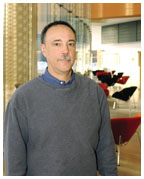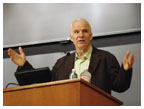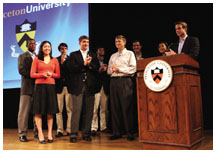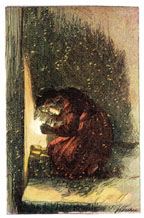
|
|
November 2, 2005: Notebook
Gearing up for growth in neuroscience
Slow gains for women in humanities, social sciences
Report: Allow four-year colleges to offer meals to club members
A visit by Bill Gates: Driving the future of technology
Endowment nets 17 percent return
Gearing up for growth in neuroscience
A laser-based technique developed by assistant professor Sam Wang exemplifies Princeton’s neuroscience research, exploring how the brain processes complex information. A glass pipet fills a nerve cell (the branched structure) with fluorescent dye; the squares show where a laser activates other cells that make connections to the nerve cell. (Courtesy Sam Wang)
David Tank (denise applewhite/office of communications) |
Neuroscience, the study of how the brain works, could be the next big thing at Princeton.
“It is a spectacularly exciting field,” said Provost Christopher L. Eisgruber ’83. “It’s a field we need to be in.”
The University hosted an external review committee in early October to review a proposal for an interdisciplinary institute that “quite possibly” could be located in a new facility, depending on fund-raising, Eisgruber said. A model would be Princeton’s Lewis-Sigler Institute for Integrative Genomics, established in 1999 to study how genes function together.
Princeton has an existing program in neuroscience for undergraduates and graduate students, but needs to respond to increasing interest in the field both at the University and at other institutions, the provost said. “We would be kidding ourselves if we thought we could retain our best neuroscientists without making a greater investment,” he said.
One challenge the University faces, Eisgruber said, is that unlike many of its competitors in the neuroscience field, Princeton does not have a medical school and would not offer a “clinically driven” program.
Professors David Tank and Jonathan Cohen have proposed a program with a different focus: “The future in our view is to understand the brain at the systems level,” said Tank, the Henry L. Hillman Professor in Molecular Biology. He said research at Princeton has focused on the areas of neural coding and neural dynamics, centered on these broad questions:
• How is information represented in the electrical and chemical activity of neurons (nerve cells) in the brain?
• How do neural circuits utilize and modify this information in the process of producing behavior?
As examples, Tank cited research into how visual recognition of a face takes place, or how decisions are made.
“The major thrust is to characterize and understand the forms of dynamics” that neuron systems use to compute and to function, Tank said. “An emphasis like this is not currently the focus of any major institution that we’re aware of.” He said this focus capitalizes on the strength of the faculty, noting a cluster of professors hired in psychology, molecular biology, and physics in the past six or seven years with expertise in the field.
“One of the last great frontiers of science is knowing how the brain works,” Tank said. “The next 50 years will be the time when a lot of fundamental questions will be addressed and answered.”
The number of undergraduates pursuing a certificate in neuroscience has been increasing, he said, noting that students from more traditional fields like psychology and molecular biology are being joined by students with majors as varied as computer science, philosophy, and art history. The number of juniors enrolled in the program, 24, is nearly double the number of students in each of the three previous classes.
At the same time, Tank said, “There is a groundswell from the faculty for a more coherent program. The curriculum needs to be expanded and coordinated.”
Eisgruber said the plans are “already creating excitement”
among the faculty. He said the purpose of the external review committee
is to “look at the proposal and to tell us, if we do neuroscience
this way, can we do it successfully at Princeton?” If the answer
is yes, he said, the University hopes to move ahead rapidly. ![]()
By W.R.O.

(Frank Wojciechowski) |
Tracy Vu ’09, left, and Rebecca Legett ’08 fight for possession
of the cane on Poe Field during the traditional competition between freshmen
and sophomores. More than 1,600 students participated in the Sept. 28
event, which included 14 sports. The Class of 2009 carried the day. ![]()

FYI—Findings
Neighborhood gap
In examining the academic achievement gap between black students and
white students, many researchers have pointed to racial segregation in
schools. But a student’s neighborhood may play an even more prominent
role, according to a recent study by Jesse Rothstein, assistant professor
of economics and public affairs, and his colleague David Card of the University
of California, Berkeley. Models that examined the effects of both school
segregation and neighborhood segregation showed that segregated neighborhoods
had a significant negative effect on the SAT scores of black students.
The impact of segregated schools was much smaller.
![]()

Slow gains for women in humanities, social sciences
|
Percentage of female professors at Princeton |
||||
| 1992 |
1997
|
2002
|
2005
|
|
| Humanities | 26.5 | 26.3 | 30.3 | 31.1 |
| Social Sciences | 19.2 | 25.9 | 22.6 | 22.8 |
| Natural Sciences | 11.2 | 14.0 | 16.0 | 17.9 |
| Engineering | 3.0 | 7.8 | 10.1 | 13.7 |
| Source: Office of the Dean of the Faculty | ||||
The proportion of women faculty in the humanities and social sciences at Princeton grew gradually from 1992 to 2002, but most departments have not fully utilized the pool of women Ph.D.s in their hiring, according to a study released by the dean of the faculty’s office on Oct. 6.
The report, a companion piece to the September 2003 task force report on women faculty in the natural sciences and engineering, found that the representation of women in the humanities and social sciences grew from 23.2 percent in 1992 to 26.9 percent in 2002. The rate of increase was “disturbing,” the report said, and “particularly unsettling” for the rank of assistant professor, where the percentage of women did not change in the 10-year period. As of October 2005, women comprised 27.2 percent of the humanities and social sciences faculty, according to the dean of the faculty’s office.
Joan Girgus, a professor of psychology and special assistant to the dean of the faculty, researched and drafted the new report, which showed several parallels to the 2003 findings about women in the sciences. “I think both reports suggest that the biggest problem across the board is a problem of representation,” she said. “There are just too few women faculty — fewer women than one might predict, knowing what the Ph.D. pools look like.”
In eight of the 19 humanities and social science departments, women accounted for more than half of the Ph.D. recipients in the U.S. from 1991 to 1996. But in 2002, only two departments at Princeton had more women professors than men (comparative literature and Slavic languages and literature).
The report found no differences in the salaries of men and women in the humanities and social sciences at Princeton, when department and rank are taken into account, and women and men in the humanities had a similar rate of earning tenure. In the social sciences, women showed a significantly better tenure record than men: Of professors hired from 1980 to 1994, 42 percent of women were granted tenure, compared to 23 percent of men. At the same time, the report found that senior women faculty were more likely to leave Princeton than male professors.
Historically, the number of women in departmental leadership positions has been low. Women were selected for just 11 of the 169 terms as department chair or dean in the humanities and social sciences from 1976 to 2002. But at the start of the 2005–06 academic year, women held eight of the 22 chair or dean positions in the departments, schools, and centers of the humanities and social sciences, an important development because, as the report states, “It seems likely that department chairs are the single most powerful influence in determining the departmental climate for women.”
Girgus, who was appointed by President Tilghman in 2003 to examine gender
issues for the dean of the faculty’s office, said the report shows
a need for looking beyond professional issues, such as hiring, tenure,
and promotion. “We really need to focus as much attention on our
policies and practices, and the availability of resources that will help
people balance work and family life, if we want people to be able to do
their best work at Princeton,” she said. “And I don’t
think that’s just about women.”
![]()
By B.T.

Report: Allow four-year colleges to offer meals to club members
The new four-year residential colleges should work with eating clubs to make it possible for juniors and seniors to belong to both a residential college and a club, according to a task force assigned to examine dining and social options.
Professor of German Michael Jennings, a former master of Rockefeller College, headed the task force and presented its report at the Oct. 10 meeting of the Council of the Princeton University Community. The four-year colleges, which will open in the fall of 2007, are likely to benefit independent students, who Jennings said are currently “ill-served.” But avoiding social segmentation will be key to the residential colleges’ success, he added.
“If the colleges only appealed to independent students — to those students not drawn to the eating clubs on Prospect Street — then the four-year colleges were going to be branded as a non-Princeton experience,” Jennings said. “The task force has tried to get past that notion.”
The report suggested that the four-year colleges should offer meal plans and events that reach out to all upperclassmen, not just those in residence. Under one recommended provision, upperclassmen who are not residents of the colleges would be allowed to eat twice a week at college dining halls. Another recommendation envisions college residents who are members of eating clubs dividing their meals equally between their colleges and their clubs. Such a plan, the report said, “should recognize the net loss of revenue to the clubs” that would occur if members chose to split their meal contracts.
The report addressed specific issues relating to the quality of campus food, the flexibility of meal times, and the aesthetics of dining halls in all residential colleges. The task force, which included students, faculty, and administrators, recommended decentralizing Dining Services so that individual college chefs could respond to their own clientele and increase the appeal of their menus. The group also called for longer meal periods and a fourth meal time, from 10 p.m. to midnight.
In designing or redesigning dining halls, the report said the University should “be especially attentive to issues of scale and warmth.” To that end, the report recommended hiring design firms with experience in commercial restaurants.
The full report is available online at http://www.princeton.edu/~vp/cpuc/Reports/Dining
and Social Options.doc. ![]()
By B.T.

Celene Chang ’06 |
“The first time I tried writing a novel, I felt a little nervous and a little naive … I decided then that I will never lie. I will never make my characters do something for me. And that makes it all easier – if you tell the truth all the time.”
Steve Martin, actor, playwright, and fiction writer, during a reading
from his work Oct. 5 sponsored by the Program in Creative Writing. Martin
read several short pieces, excerpts from two plays, and the opening of
his 2000 novella, Shopgirl.
![]()

A visit by Bill Gates: Driving the future of technology
Bill Gates receives the Crystal Tiger Award, presented by Harrison Frist ’06, left, after his Oct. 14 speech. (Office of Communications) |
With a video-game controller in hand and the starting line of a new Xbox 360 racing game projected on the screen at Richardson Auditorium, Microsoft Chairman Bill Gates waited for the signal to turn green and pressed the gas.
“Vroom, I’m on my way now,” he joked as his Porsche sputtered and swerved down the streets of Las Vegas, scraping guardrails and riding on curbs. Gates’ driving skills may need a little work, but computing technology, he said, is already lapping the field. And in the coming decade, he added, today’s students will play an important role in creating new applications for business, science, and entertainment.
“There are great dreams about what software can do,” Gates said during an Oct. 14 visit to campus. “The pace of the field will be determined by fresh young minds that think about innovative ways of doing these things coming in and driving this work.”
Gates, who was on a three-day, six-college tour to promote computer science education, received the Crystal Tiger Award, presented by a committee of undergraduate student representatives to inspirational individuals who show “a strong commitment to enriching the human experience.” He spoke to an audience of about 1,000 students, faculty, and staff in Richardson Auditorium.
In addition to his Xbox demonstration, Gates showed a six-minute film in which he starred alongside actor Jon Heder, in character as the cult-movie hero Napoleon Dynamite. He also opened with a brief video of Microsoft’s Princeton alumni talking about their work and singing a few bars of “Old Nassau.”
But Gates’ visit covered more than fun and games. Before his speech, he met with President Tilghman, engineering dean Maria Klawe, and a dozen professors to talk about teaching initiatives in computer science. Klawe said Gates was particularly impressed with Princeton’s interdisciplinary courses for freshmen, including one that integrates computer science in the study of genomics and another in the study of engineering, math, and physics.
Senior Thomas Voûte said the Crystal Tiger Award recognized Gates’
“incomparable philanthropy” through the Bill and Melinda Gates
Foundation. ![]()
By B.T.

(From Stories for the Household, illustrated by A. W. Bayes, London: George Routledge & Sons, ca. 1875) |
The Cotsen Children’s Library will host a conference Nov. 10–12 to mark the bicentenary of HANS CHRISTIAN ANDERSEN’S birth. The program will include talks by international scholars, papers, film screenings, professional storytelling, and live dramatic productions. The schedule and abstracts of papers can be found at http://ccl.princeton.edu/Research/e396/hc_anderson.html. Contact Eric Johnson at 609-258-1148 or ejohnson@princeton.edu to register. An exhibition of artists’ interpretations of Andersen’s works will be on display in Firestone Library’s Milberg Gallery through March 26.
Bob Herbert, an op-ed columnist for The New York Times, will speak Tuesday, Nov. 8, at 8 p.m. on “The Consequences of Incompetence: The All-Too-Human Costs of Bad Thinking and Poor Decision-Making by People in High Places.” Herbert’s Stafford Little lecture will be given in McCosh 50. Times executive editor Bill Keller will speak Monday, Nov. 14, at 4:30 p.m. in Dodds Auditorium, Robertson Hall.
Documentary filmmaker RIC BURNS will give a talk and present excerpts from his latest work, on playwright Eugene O’Neill, Wednesday, Nov. 9, at 7:30 p.m. in 101 McCormick Hall.
On the weekend of the Yale football game, the Princeton and Yale GLEE CLUBS will perform Friday, Nov. 11, at 8 p.m. in Richardson Auditorium. The NASSOONS and the WHIFFENPOOFS will perform Nov. 12, also at 8 p.m. in Richardson. For tickets, call the Richardson Box Office at 609-258-5000.
IAN BURUMA, Bard College professor and author, will speak Tuesday, Nov. 15, at 7:30 p.m. in McCosh 50 on the question, “Is Democracy a Universal Value?” Buruma is the Henry Wendt III Visiting Professor, sponsored by the East Asian Studies Program.
BRUCE BABBITT, former U.S. secretary of the
interior, will speak Tuesday, Nov. 15, at 8 p.m. in Room 104 in the Computer
Science building on the need for a new national land-use policy. A reception
and book-signing will follow.
![]()

Endowment nets 17 percent return
The University’s endowment earned a 17 percent return on investments in 2004–05, its best performance since 1999–2000, according to the Princeton University Investment Company (Princo). On June 30, the end of the fiscal year, the endowment was valued at $11.2 billion, up from $9.9 billion a year ago. The change in the endowment’s value is a function of spending and gifts, as well as investment performance.
Andrew Golden, the president of Princo, said he was pleased with the annual figures but stressed the importance of long-term performance. The endowment has compounded at a rate of 15.6 percent over the last 10 years. “When you have a mission to preserve purchasing power into perpetuity, in some sense a year is a pretty short period of time,” Golden said. “Seventeen percent is gratifying, but we take that in stride, just as we would take in stride a 2 percent year.”
Princo generated its highest returns for 2005 in emerging markets (30.4 percent), private equities (29.3 percent), and real assets, including real estate, energy, and natural resource investments (27.4 percent). Golden credited managing directors Jon Erickson and Dan Feder for shaping the high-performing portfolios.
Princeton’s endowment return significantly outpaced the national median of 11.9 percent as well as the median return for the 40 largest university endowments in the United States, which was 13.6 percent, according to preliminary figures compiled by Cambridge Associates.
Harvard, which has the nation’s largest university endowment, produced a return of 19.2 percent, boosting its endowment to $25.9 billion, and Yale earned a 22.3 percent return to bring its endowment to $15.2 billion, according to The New York Times. Stanford’s endowment passed Princeton’s to become the third-largest held by a private university. Stanford’s endowment grew to $12.4 billion after earning a 19.5 percent return in 2004–05, the Stanford Management Co. reported.
Princeton’s endowment per student is the Ivy League’s highest
and was second nationally in 2004 among institutions that grant undergraduate
degrees, according to The Chronicle of Higher Education. The Franklin
W. Olin College of Engineering in Massachusetts, which has fewer than
300 students, ranked first. ![]()
By B.T.

President Tilghman has been elected a member of the BOARD OF DIRECTORS OF GOOGLE, the search engine giant. Eric Schmidt ’76, who is chairman and CEO of Google as well as a member of the University’s board of trustees, praised Tilghman’s “extraordinary talents as an accomplished academic and as a champion of discovery.” Tilghman said Princeton’s trustees have encouraged her to join a corporate board, and that she had declined previous offers because she wanted to concentrate on her University duties. Her compensation from Google includes an award that can be converted into 6,000 shares of Google stock over five years, plus 12,000 stock options that can be exercised over the next 10 years.
AN UNMANNED VEHICLE engineered by a team of Princeton
undergraduates made it to the final round of the $2 million Grand Challenge
competition, sponsored by the federal Defense Advanced Research Projects
Agency. But a glitch in navigation software knocked the vehicle, called
Prospect 11, out of the Oct. 8 competition just 10 miles into the 132-mile
course across the Mojave Desert. A team from Stanford captured the prize.
![]()






